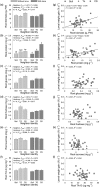Root volatiles in plant-plant interactions II: Root volatiles alter root chemistry and plant-herbivore interactions of neighbouring plants
- PMID: 30754075
- PMCID: PMC6849603
- DOI: 10.1111/pce.13534
Root volatiles in plant-plant interactions II: Root volatiles alter root chemistry and plant-herbivore interactions of neighbouring plants
Abstract
Volatile organic compounds (VOCs) emitted by plant roots can influence the germination and growth of neighbouring plants. However, little is known about the effects of root VOCs on plant-herbivore interactions of neighbouring plants. The spotted knapweed (Centaurea stoebe) constitutively releases high amounts of sesquiterpenes into the rhizosphere. Here, we examine the impact of C. stoebe root VOCs on the primary and secondary metabolites of sympatric Taraxacum officinale plants and the resulting plant-mediated effects on a generalist root herbivore, the white grub Melolontha melolontha. We show that exposure of T. officinale to C.stoebe root VOCs does not affect the accumulation of defensive secondary metabolites but modulates carbohydrate and total protein levels in T. officinale roots. Furthermore, VOC exposure increases M. melolontha growth on T. officinale plants. Exposure of T. officinale to a major C. stoebe root VOC, the sesquiterpene (E)-β-caryophyllene, partially mimics the effect of the full root VOC blend on M. melolontha growth. Thus, releasing root VOCs can modify plant-herbivore interactions of neighbouring plants. The release of VOCs to increase the susceptibility of other plants may be a form of plant offense.
Keywords: associational effects; belowground herbivory; neighbourhood effects; plant-herbivore interactions; plant-plant interactions; volatile priming.
© 2019 The Authors Plant, Cell & Environment Published by John Wiley & Sons Ltd.
Figures




Similar articles
-
Root volatiles in plant-plant interactions I: High root sesquiterpene release is associated with increased germination and growth of plant neighbours.Plant Cell Environ. 2019 Jun;42(6):1950-1963. doi: 10.1111/pce.13532. Epub 2019 Mar 28. Plant Cell Environ. 2019. PMID: 30737807 Free PMC article.
-
Impact of Seasonal and Temperature-Dependent Variation in Root Defense Metabolites on Herbivore Preference in Taraxacum officinale.J Chem Ecol. 2020 Jan;46(1):63-75. doi: 10.1007/s10886-019-01126-9. Epub 2019 Dec 12. J Chem Ecol. 2020. PMID: 31832894 Free PMC article.
-
A beta-glucosidase of an insect herbivore determines both toxicity and deterrence of a dandelion defense metabolite.Elife. 2021 Oct 11;10:e68642. doi: 10.7554/eLife.68642. Elife. 2021. PMID: 34632981 Free PMC article.
-
Specificity and context-dependency of plant-plant communication in response to insect herbivory.Curr Opin Insect Sci. 2019 Apr;32:15-21. doi: 10.1016/j.cois.2018.09.003. Epub 2018 Sep 10. Curr Opin Insect Sci. 2019. PMID: 31113626 Review.
-
The specificity of herbivore-induced plant volatiles in attracting herbivore enemies.Trends Plant Sci. 2012 May;17(5):303-10. doi: 10.1016/j.tplants.2012.03.012. Epub 2012 Apr 12. Trends Plant Sci. 2012. PMID: 22503606 Review.
Cited by
-
Enzymatic fermentation of rapeseed cake significantly improved the soil environment of tea rhizosphere.BMC Microbiol. 2023 Sep 7;23(1):250. doi: 10.1186/s12866-023-02995-7. BMC Microbiol. 2023. PMID: 37679671 Free PMC article.
-
Identification and expression analysis of TPS family gene in Cannabis sativa L.Heliyon. 2024 Mar 16;10(6):e27817. doi: 10.1016/j.heliyon.2024.e27817. eCollection 2024 Mar 30. Heliyon. 2024. PMID: 38545150 Free PMC article.
-
Adaptive mechanisms of plant specialized metabolism connecting chemistry to function.Nat Chem Biol. 2021 Oct;17(10):1037-1045. doi: 10.1038/s41589-021-00822-6. Epub 2021 Sep 22. Nat Chem Biol. 2021. PMID: 34552220 Review.
-
The Composition, Antioxidant and Antibacterial Activity of Essential Oils from Five Species of the Magnoliaceae Family.Molecules. 2024 Nov 1;29(21):5182. doi: 10.3390/molecules29215182. Molecules. 2024. PMID: 39519823 Free PMC article.
-
Endophytic Pseudomonas fluorescens relieves intraspecific allelopathy of Atractylodes lancea by reducing ethylene transportation.BMC Plant Biol. 2024 Nov 19;24(1):1095. doi: 10.1186/s12870-024-05826-7. BMC Plant Biol. 2024. PMID: 39558284 Free PMC article.
References
-
- Arimura, G.‐I. , Ozawa, R. , Shimoda, T. , Nishioka, T. , Boland, W. , & Takabayashi, J. (2000). Herbivory‐induced volatiles elicit defence genes in lima bean leaves. Nature, 406, 512–515. - PubMed
-
- Barbosa, P. , Hines, J. , Kaplan, I. , Martinson, H. , Szczepaniec, A. , & Szendrei, Z. (2009). Associational resistance and associational susceptibility: Having right or wrong neighbors. Annual Review of Ecology, Evolution, and Systematics, 40, 1–20. 10.1146/annurev.ecolsys.110308.120242 - DOI
-
- Bates, D. , Mächler, M. , Bolker, B. , & Walker, S. (2015). Fitting linear mixed‐effects models using lme4. Journal of Statistical Software, 67, 1–48.
-
- Benjamini, Y. , & Hochberg, Y. (1995). Controlling the false discovery rate: A practical and powerful approach to multiple testing. Journal of the Royal Statistical Society Series B‐Statistical Methodology, 57, 289–300.
Publication types
MeSH terms
Substances
Grants and funding
LinkOut - more resources
Full Text Sources

